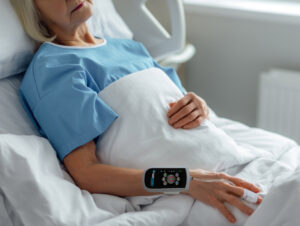
Caretaker Medical Partners with Red One Medical to Bring Mobile ICU-Level Monitoring to Military Units and Veterans
Caretaker Medical’s advanced hemodynamic monitoring devices are now available to military units and Veterans Affairs, up-leveling the care of U.S. soldiers and veterans.
Caretaker Medical and Red One Medical have partnered to bring ICU-level hemodynamic and vital signs monitoring to military units with an aim to enable safer care for soldiers and veterans.
Caretaker’s VitalStream will provide military teams with the ability to measure continuous blood pressure, continuous cardiac output and other advanced hemodynamic measures including fluid responsiveness. Continuous monitoring allows deterioration or clinical events to be detected sooner, leading to earlier intervention and potentially better outcomes.
Military medics execute life-saving care in the field, including anesthetizing patients and performing surgical procedures. Currently, a patient’s blood pressure (BP) is monitored with intermittent spot checks using a blood pressure cuff. This can allow for blind spots where sudden drops in BP are undetected. This is significant because available analyses suggest that even short periods of hypotension below mean arterial pressures (MAP) of 50 to 65 mmHg, are associated with kidney and myocardial injury.1
“VitalStream is the best pre-hospital device for patient monitoring I have seen,” described Tim Fazekas, a Marine Corps veteran with extensive experience in field and hospital critical care, and clinical affairs specialist for Red One Medical. “Military units will have the ability to conduct operating room and ICU-level monitoring in a tent. There is nothing like this currently available for the field.”
VitalStream is the world’s only wireless, wearable ICU-grade monitor to be clinically validated and FDA-cleared. It uses a low-pressure finger sensor and patented Pulse Decomposition Analysis to measure advanced hemodynamic parameters. Its compact size makes it easy for military medics to carry whether traveling via helicopter, vehicle or on foot.
VitalStream can also be used to monitor special warfare students to help make it safer for those going through training.
“Training is strenuous and some students can push themselves through dehydration, injury or illness. This can put them at risk for serious medical issues including sepsis, described Fazekas. “VitalStream can be used to help monitor students and identify who needs care, essentially making training safer.”
The teams at Caretaker Medical and Red One Medical see many ways for VitalStream to help improve the care of veterans and military members. About eight million patients die annually within 30 days of a major surgery.2 VitalStream could be used at VA hospitals as a clinically-relevant alternative to invasive arterial lines and pulmonary artery catheters. This could broaden monitoring to additional patients, improve the monitoring experience and reduce complications from invasive procedures. VitalStream could even extend monitoring for veterans to other areas of the hospital, or beyond the hospital and into veterans’ homes.
Another Caretaker product, VitalStation™, could be used to centrally monitor patients at VA hospitals and act as an integration point to stream data into the EHR. It could also be used to centrally monitor military patients and help medics prioritize medical resources, which can be limited in the field.
“This partnership shows our dedication to delivering best-in-class medical devices for service members and veterans,” stated Red One Medical CEO, Charles Pollak. “Many of our employees are veterans with field and medical experience. We have identified VitalStream as an incredibly meaningful product that has the potential to help improve care for all veterans and military members.”
VitalStream and VitalStation are now available on ECAT, a streamlined procurement method for the Department of Defense (DOD) and Veterans Affairs (VA). ECAT provides the DOD and VA the ability to purchase the devices they need unincumbered.
About Red One Medical
Red One Medical identifies and delivers advanced medical and pharmaceutical technologies that transform care for America’s veterans and military service members. Located in Savannah, GA, Red One Medical is a CVE-certified Service Disabled Veteran Owned Business (SDVOSB). It donates a portion of profits to charities that support veterans, military families and their communities.
About Caretaker Medical
Caretaker Medical is a Charlottesville, Virginia based digital health company focused on developing wireless, high-acuity, continuous patient monitoring platforms that improve outcomes, increase clinician productivity and maximize patient compliance and comfort.
Sources:
- Vafi Salmasi, M.D.; Kamal Maheshwari, M.D., M.P.H.; Dongsheng Yang, M.A.; Edward J. Mascha, Ph.D.; Asha Singh, M.D.; Daniel I. Sessler, M.D.; Andrea Kurz, M.D. Relationship between Intraoperative Hypotension, Defined by Either Reduction from Baseline or Absolute Thresholds, and Acute Kidney and Myocardial Injury after Noncardiac Surgery: A Retrospective Cohort Analysis.
- Geoffrey P. Dobson, Trauma of major surgery: A global problem that is not going away. International Journal of Surgery, Volume 81, 2020, Pages 47-54, ISSN 1743-9191, https://doi.org/10.1016/j.ijsu.2020.07.017.
More medical news and events

Caretaker Medical Receives Inaugural Healthcare Tech Innovation Award and $200,000 Grant from Medical Society of D.C.
WASHINGTON, DC, UNITED STATES, April 2, 2025 /EINPresswire.com/ -Caretaker Medical is honored to announce it has been awarded the Healthcare Technology Innovation Award, along with…

Caretaker Medical Awarded the Grand Prize in NIH RADx Tech for Maternal Health Challenge
Caretaker Medical, a digital health company focused on developing hemodynamic monitoring devices, today announced that it has been awarded the $525,000 grand prize in the…

VitalStream offers continuous hemodynamic monitoring solution amid IV fluid shortage
Philadelphia, PA – October 9, 2024 – Caretaker Medical, a pioneer in advanced hemodynamic monitoring technology, is highlighting the critical role of its VitalStream solution…
